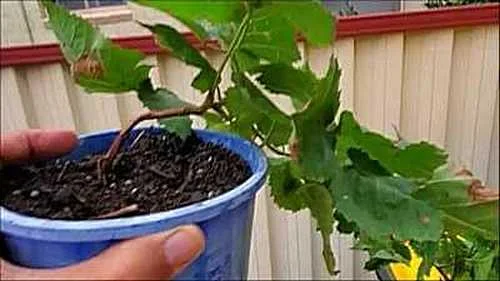Layering methods are described for plant propagation or cloning trees easily. Learn how to air layer trees including fruit trees.
Layering propagation is a technique of plant propagation where a portion of the stem remains attached to the parent plant, while growing new roots. The stem is then detached as a new plant.
The best time to air layer plants like lemon, lime, citrus, and other trees is in late winter and early spring. The plant propagation by layering method has high success rate (around 90%) as compared to the propagation from cuttings.
This is because in the layering method, the portion being propagated continues to receive water and nutrients from the parent plant while it is forming roots. Leaf cutting propagation
Layering Propagation Methods
 |
| Blackberry plant grown from tip layering method |
There are two ways to layer plants.
Ground-Layering Method For Propagation
The ground-layering is the simplest method. This method is good for layering shrubs where their low branches can be bent and buried in soil to develop roots. Layering plant examples by this method are camellias, jasmine, mandevilla, daphne, the boxwood, forsythia, blackberries, etc.
1. Tip Layering
Select a healthy stem tip about 15 centimetre long and scrape the top layer of the stem to expose the cambium layer and then bury in the ground. You will see new growth in 2-3 months time, then cut it off from the parent plant and then transplant it as a new plant.
2. Simple Layering
This is done by bending the middle of a stem and pushing it underground and kept in place with a U-shaped pin. Roots will form at the stem that is underground.
3. Serpentine Layering
You can also put 2-3 portions of the stem underground in a serpentine manner. The serpentine layering works for long, flexible branches.
Air Layering Method For Propagation
 |
| Rubber plant air-layering |
The air layering or aerial layering method is the most reliable and the easiest layering method to clone a plant. It produces a genetically identical tree, so it is a vey good method, specially for a fruit tree to create a copy of the tree.
In air layering, the plant is wounded and some rooting hormone is optionally applied around the wound which encourages to grow roots. It is then surrounded in a moist medium such as sphagnum or coir peat moss, which is wrapped in a polyethylene sheet to retain moisture inside. The stem from the parent plant is removed when sufficient roots grow at the wound.
In woody stems, make a cut in the the bark around the stem just below a node with a sharp knife. Make another similar cut around the stem about 1 inch below the first cut. Lightly scrape the bark between the two cuts to remove cambial tissue, the first layer of tissue underneath the bark. Apply some rooting hormone and surround in a moist medium .
In this layering method, the air layer can even be left unattended for long periods to grow stronger roots, without the roots dying.
By the air layering technique, you get a good-sized plant in only a few weeks instead of many months and years, and even get flowers and fruits quite quickly.
What trees can be air layered?
The examples of trees that can be air-layered successfully are magnolias, rubber plant, rhododendron, and fruit trees like apple, apricot, blackberries, cherry, figs, guava, lime, lemon, longan, lychee, macadamia, sapodilla, sapote, etc. Many Australian natives are also perfect for aerial layering.
YouTube Video on Propagation by air layering method
Lemon tree propagation from air layering youtube video
Croton propagation from air layering youtube video
How to plant little gem magnolia tree